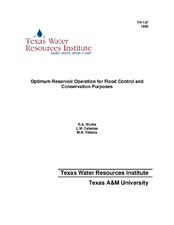| dc.description.abstract | Rapid population and economic growth in Texas is accompanied by increased needs for water supply and flood control. Depleting groundwater reserves are resulting in an increased reliance on surface water. The rising cost of fossil fuel during the 1970's has focused attention on increasing hydroelectric power generation. Instream flow needs for fish and wildlife habitat and maintenance of fresh water inflows to bays and estuaries have received increased attention in recent years. The climate of the state is characterized by extremes of floods and droughts. Reservoirs are necessary to control and utilize the highly variable streamflow. Due to a number of economic, environmental, institutional, and political factors, construction of additional new reservoir projects is much more difficult now than in the past. Consequently, optimizing the beneficial use of existing reservoirs is becoming increasingly more important.
In addition to ever increasing water related needs, other factors affecting reservoir operation change over time as well. Watershed and flood plain conditions are dynamic. Construction of numerous small flood retarding dams by the Soil Conservation Service and other entities in the watersheds of major reservoirs have reduced flood inflows to the reservoirs. Construction of numerous small ponds for recreation or watering livestock have also decreased reservoir inflows and yields. Increased runoff caused by watershed urbanization is significantly contributing to flooding problems in certain locations. The existing flood control reservoirs were planned and designed based on the expectation of ever increasing intensification of flood plain land use. However, the National Flood Insurance Program has resulted in zoning and regulation of 100-year flood plains. With stringent flood plain management, susceptibility to flooding could actually decrease over time as existing activities choose to leave the flood plain and regulation prevents other activities from moving into the flood plain. Reservoir sedimentation reduces available storage capacity. Construction of additional reservoirs, as well as other related types of projects such as conveyance facilities, flood control levees and channel improvements, and electric power plants, affect the operation of existing reservoirs. Technological advancements in hydrologic data collection, streamflow forecasting, system modeling and analysis, and computer technology provide opportunities for refining operating policies.
Reservoir storage capacities and operating policies are generally established prior to construction and tend to remain constant thereafter. However, public needs and objectives and numerous factors affecting reservoir effectiveness significantly change over time. The increasing necessity to use limited storage capacity as effectively as possible warrants periodic reevaluations of operating policies. Operating procedures should be responsive to changing needs and conditions.
Reallocation of storage capacity between flood control and conservation purposes represents one general strategy for modifying operating policies in response to changing needs and conditions. Reservoir operation is based upon the conflicting objectives of maximizing the amount of water available for conservation purposes and maximizing the amount of empty space available for storing flood waters. Conservation purposes include municipal, industrial, and agricultural water supply, hydroelectric power, recreation, and instream flow maintenance. Common practice is to operate a reservoir only for conservation purposes or only for flood control or to designate a certain reservoir volume, or pool, for conservation purposes and a separate pool for flood control. The conservation and flood control pools in a multiple purpose reservoir are fixed by a designated top of conservation (bottom of flood control) pool elevation. Planning, design, and operating problems associated with flood control are handled separately from those associated with conservation. Institutional arrangements are also based on separating flood control and conservation purposes. Increasing needs for providing water for various uses and reducing flood damages necessitate that limited reservoir storage capacity be used as beneficially as possible. Consequently, consideration of the interactions and tradeoffs between conservation and flood control operations is becoming increasingly more important.
The traditional analysis methods and practices followed in planning and design of reservoir projects and during real-time operations have not really addressed the tradeoffs and interactions between flood control and conservation purposes. In general, expanded analysis capabilities are needed for periodically reevaluating the operating policies of existing reservoir systems. A particular need in this regard is for improved methods for evaluating the tradeoffs involved in reallocating storage capacity between flood control and conservation purposes. | en |


